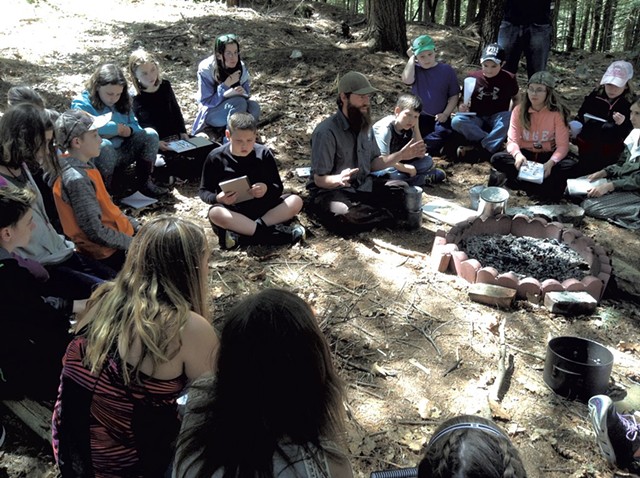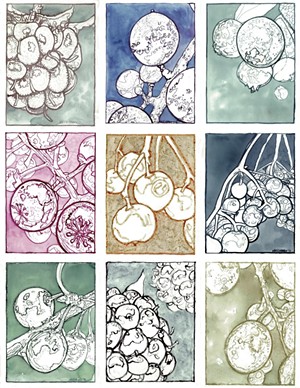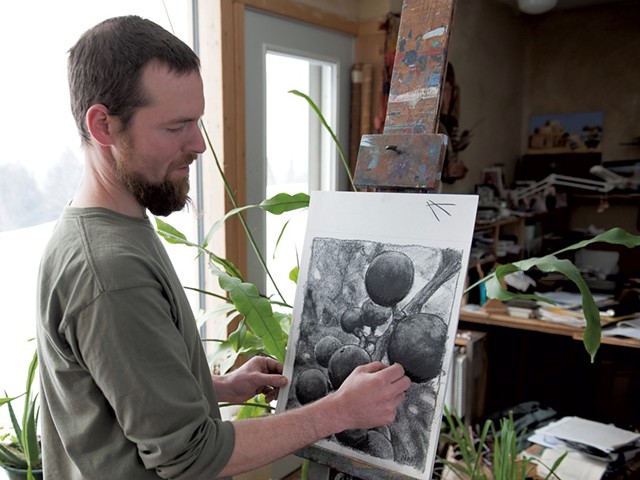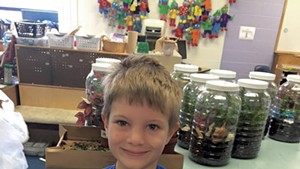
- Courtesy of Nick Neddo
- Nick Neddo instructing a group of students
After years of feeling pulled between two passions: making art and studying, teaching and practicing Stone Age technology, Nick Neddo asked himself two questions. "If I lived in the Stone Age, would I consider myself an artist? And I realized that the answer would be yes because that's just who I am. And the next question was, what would art look like if I did live in the Stone Age?"
That question has led him to an ongoing exploration of making art supplies — charcoal sticks, pens, brushes, crayons, inks, paints, and even inkwells and paint dishes — from natural materials and then, making art with them. The results can be seen in his 2015 how-to book, The Organic Artist: Make Your Own Paint, Paper, Pigments, Prints, and More from Nature. His drawings and paintings depict bamboo, willow, acorns, berries and other sources of the materials he uses.

- Courtesy of Nick Neddo
- Neddo's drawings of berries using ink made from each berry
Although high-quality commercial art supplies are readily available, they are expensive and some, such as brush-cleaning solvents and lead-sourced pigments, can be toxic, Neddo said. His creative process could start with a pen in his hand at his desk, he said. "Or it can start with my feet on the ground out in some beautiful place... Being on the landscape foraging feels natural to me, and it feels good." It offers Neddo, a sixth-generation Vermonter, the chance to develop a deeper knowledge of plants, a perspective on geology, connection to the landscape and a sense of place, he said. A recent outing brought him face-to-face with a young barred owl. He was following a stream in the forest near his East Montpelier home, looking for stones from which to make paint, when he heard fluttering in the branches. He and the owl studied each other for a few moments. That, he said, never happens in an art store.
For 18 years, Neddo, 39, has worked as an independent educator, teaching kids and adults wilderness survival and living skills, tracking, drawing and nature awareness in Vermont and elsewhere. He has visited several Vermont schools as an artist-in-residence. Since his book was published, demand for his art classes has increased. While making paint from rocks and ink from berries is fun, his overarching goal is to help his students reclaim their relationship with nature and become ecologically responsible. "That land steward, caretaker relationship is the bigger picture here," he said. "All creatures have a give-and-take relationship with the ecosystem. For humans, it's the same thing."
Hunt, Gather and Draw

- Courtesy of Susan Teare
- Neddo draws with charcoal he made from wild grapevine
- To make paint, find a rock that draws like chalk, one that leaves a line when you scratch it on another stone. Grind it onto a larger rock, going back and forth over the same line, pushing hard, until you have a pile of powder. That's your pigment. (Vermont rocks yield hues of virtually every color of the rainbow.) All you need to do after that is add a binding agent. "You can just spit in it and mix it with your finger, and you have a really simple paint," Neddo said. However, he acknowledged, "The spit thing can get kind of gross." Diluted honey, Elmer's glue or maple syrup also work. Proportions don't need to be exact: about one part honey, glue or syrup to five or 10 parts water.
- Make a pen by finding a pen-sized stick. With a pocket knife, carve one end to a sharp point, and remove the bark two inches up the shaft from the point. Soak the debarked end in water for 30 minutes to open the wood and improve ink retention and flow. Then, dip the pen in ink and draw!
- Inks can be made from coffee, beets and berries. Try these techniques:
- Brew a strong pot of coffee. Pour some for your parents, and use the rest as ink. If you want it to be darker, reduce it on low heat until it reaches the desired saturation.
- Cover one cup of finely chopped beets with two cups of water and boil them for about 45 minutes. The resulting water is brown ink. Reduce it to desired saturation. Add 1 teaspoon vinegar and 1 teaspoon salt to help it last longer.
- For magenta ink, juice fresh beets or puree them in a blender, squeeze them in a cheesecloth and collect the vibrant juice.
- Any berry in season can make ink. "The more succulent and juicy they are, the better," Neddo writes in his book. "The hardest part of making ink with berries is that you cannot eat them." The easiest way to make ink is to put the berries in a Ziploc bag, crush them and freeze them. When the berries thaw, pigment will puddle in the bottom of the bag.
- These are small-batch inks intended for immediate use. Refrigerate them, and they will last a few days. Adding rosemary essential oil to them will inhibit growth of mold and bacteria.











Comments
Comments are closed.
From 2014-2020, Seven Days allowed readers to comment on all stories posted on our website. While we've appreciated the suggestions and insights, right now Seven Days is prioritizing our core mission — producing high-quality, responsible local journalism — over moderating online debates between readers.
To criticize, correct or praise our reporting, please send us a letter to the editor or send us a tip. We’ll check it out and report the results.
Online comments may return when we have better tech tools for managing them. Thanks for reading.